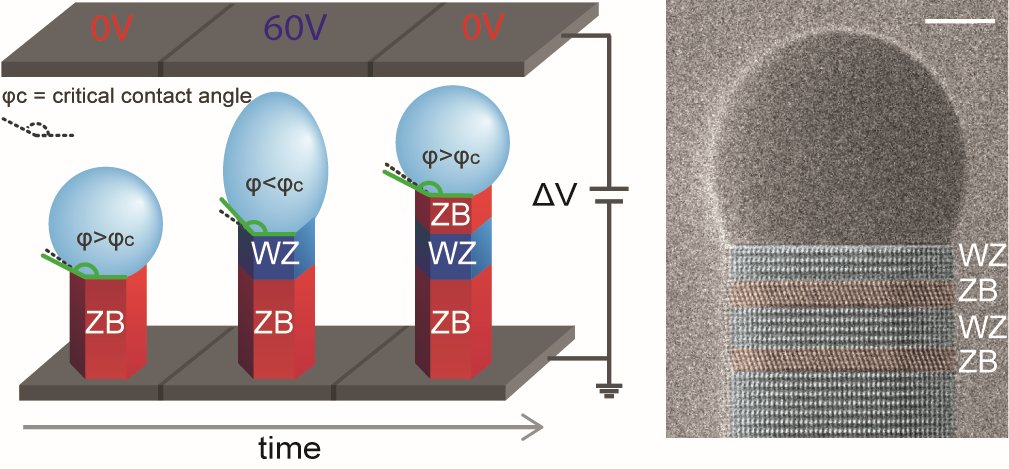ANR ELEPHANT
Back to In-Situ Electron Microscopy for Nanomaterial Synthesis
Contact: Federico PANCIERA
Electric-field-assisted phase switching for crystal phase quantum dot fabrication in GaAs nanowires
Project ANR-21-CE30-0012-01
This project is built on the concept of a novel type of quantum dots: crystal-phase quantum dots (CPQDs), which consist of heterostructures made with a single material but having different crystal phases. Compared to conventional quantum dots, formed using different materials, CPQDs have a unique advantage: they can be grown with the ultimate accuracy of a single atomic layer. This advantage will break the major limitation in the field of optically-active quantum dots: they cannot be built with the required control to form a device that necessitates multiple quantum dots.

Figure caption. Crystal phase changes induced by an E-field. (left) Schematic view of the experimental setup showing that applying an E-field during growth induces the crystal phase switching in GaAs nanowires. The E-field dynamically deforms the catalyst droplet, modulating its contact angle beyond a critical threshold to trigger zinc blende (ZB)–wurtzite (WZ) transitions with monolayer precision. (right) Example of crystal phase quantum dots fabricated by the E-field method. The scale bar is 5 nm.
CONTEXT: Bulk semiconductors generally exist in only one crystal phase, but at the nanoscale, multiple crystal phases can coexist. This occurs, for example, when GaAs nanowires (NWs) are grown using the vapor-liquid-solid (VLS) method. In these wires, the stable zincblende (ZB) phase coexists with metastable wurtzite (WZ) structure, resulting in NWs having a mixed-phase structure. Remarkably, the valence and conduction bands of the two phases are misaligned so that small sections of one phase within the other effectively confine charge carriers. These heterostructures are defined as CPQDs and have been proposed for several potential applications in photonics and quantum computing thanks to their extraordinary properties. They feature sharp and intense spectral lines, single-photon emission, and two-photon cascade biexciton-exciton complex. Moreover, in contrast to compositional heterojunctions, CPQDs have intrinsically strain-free and abrupt interfaces and hence do not suffer from alloy intermixing, which hampers precise control of the electronic properties in compositional heterostructures.
OBJECTIVES: In this project, we will use an e-field to trigger the phase change in GaAs NWs and in doing so, create CPQDs with the ultimate monolayer precision. This will represent a breakthrough in the fabrication of CPQDs and, in general, in the synthesis of semiconducting quantum dots. For the first time, it will be possible to reliably synthesize multiple quantum dots with controlled size and spacing.
PUBBLICATIONS:






